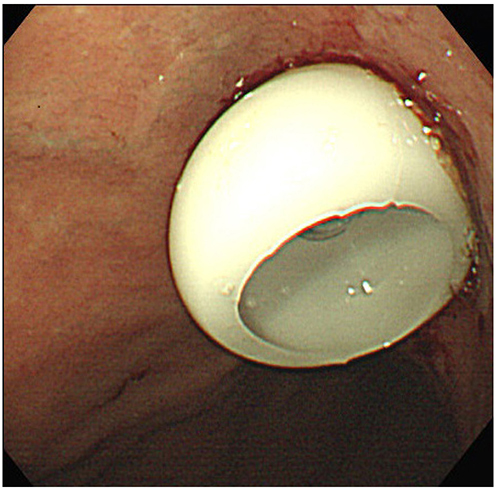Korean J Gastroenterol.
2018 Dec;72(6):308-312. 10.4166/kjg.2018.72.6.308.
Percutaneous Endoscopic Gastrostomy Tube Insertion-induced Superior Mesenteric Artery Injury Treated with Angiography
- Affiliations
-
- 1Division of Gastroenterology, Department of Internal Medicine, Chungnam National University School of Medicine, Daejeon, Korea. mhs1357@cnuh.co.kr
- KMID: 2429948
- DOI: http://doi.org/10.4166/kjg.2018.72.6.308
Abstract
- Percutaneous endoscopic gastrostomy (PEG) is widely used to provide nutritional support for patients with dysphagia and/or disturbed consciousness preventing oral ingestion, and PEG tube placement is a relatively safe and convenient non-surgical procedure performed under local anesthesia. However, the prevention of PEG-insertion-related complications is important. A 64-year-old man with recurrent pneumonia underwent tracheostomy and nasogastric tube placement for nutritional support and opted for PEG tube insertion for long-term nutrition. However, during the insertion procedure, needle puncture had to be attempted twice before successful PEG tube placement was achieved, and a day after the procedure his hemoglobin had fallen and he developed hypotension. Abdominal computed tomography revealed injury to a pancreatic branch of the superior mesenteric artery (SMA) associated with bleeding, hemoperitoneum, and pancreatitis. Transarterial embolization was performed using a microcatheter to treat hemorrhage from the injured branch of the SMA, and the acute pancreatitis was treated using antibiotics and supportive care. The patient was discharged after an uneventful recovery. Clinicians should be mindful of possible pancreatic injury and bleeding after PEG tube insertion. Possible complications, such as visceral injuries or bleeding, should be considered in patients requiring multiple puncture attempts during a PEG procedure.
Keyword
MeSH Terms
Figure
Reference
-
1. Gauderer MW, Ponsky JL, Izant RJ Jr. Gastrostomy without laparotomy: a percutaneous endoscopic technique. J Pediatr Surg. 1980; 15:872–875.
Article2. Löser C, Müller MJ. Ethical guidelines for performing percutaneous endoscopic gastrostomy (PEG catheter). Z Gastroenterol. 1998; 36:475–478.3. Rabeneck L, McCullough LB, Wray NP. Ethically justified, clinically comprehensive guidelines for percutaneous endoscopic gastrostomy tube placement. Lancet. 1997; 349:496–498.
Article4. Löser C, Wolters S, Fölsch UR. Enteral long-term nutrition via percutaneous endoscopic gastrostomy (PEG) in 210 patients: a four-year prospective study. Dig Dis Sci. 1998; 43:2549–2557.5. Grant JP. Comparison of percutaneous endoscopic gastrostomy with Stamm gastrostomy. Ann Surg. 1988; 207:598–603.6. ASPEN Board of Directors and the Clinical Guidelines Task Force. Guidelines for the use of parenteral and enteral nutrition in adult and pediatric patients. JPEN J Parenter Enteral Nutr. 2002; 26:1 Suppl. 1SA–138SA.7. Löser C, Aschl G, Hébuterne X, et al. ESPEN guidelines on artificial enteral nutrition--percutaneous endoscopic gastrostomy (PEG). Clin Nutr. 2005; 24:848–861.8. Lee HJ, Choung RS, Park MS, et al. Two cases of uncommon complication during percutaneous endoscopic gastrostomy tube replacement and treatment. Korean J Gastroenterol. 2014; 63:120–124.
Article9. Schrag SP, Sharma R, Jaik NP, et al. Complications related to percutaneous endoscopic gastrostomy (PEG) tubes. A comprehensive clinical review. J Gastrointestin Liver Dis. 2007; 16:407–418.10. Naik RP, Joshipura VP, Patel NR, Haribhakti SP. Complications of PEG--prevention and management. Trop Gastroenterol. 2009; 30:186–194.11. Smale E, Davison AM, Smith M, Pritchard C. Fatal intra-abdominal haemorrhage following percutaneous endoscopic gastrostomy. BMJ Case Rep. 2009; 2009:bcr06.2009.2044.
Article12. Lau G, Lai SH. Fatal retroperitoneal haemorrhage: an unusual complication of percutaneous endoscopic gastrostomy. Forensic Sci Int. 2001; 116:69–75.
Article13. Lim YJ, Yang CH. Technique, management and complications of percutaneous endoscopic gastrostomy. Korean J Gastrointest Endosc. 2009; 39:119–124.14. Fang JC. Minimizing endoscopic complications in enteral access. Gastrointest Endosc Clin N Am. 2007; 17:179–196. ix
Article15. Patel BB, Andrade C, Doraiswamy V, Amodeo D. Splenic avulsion following PEG tube placement: a rare but serious complication. ACG Case Rep J. 2014; 2:21–23.
Article16. Rabeneck L, Wray NP, Petersen NJ. Long-term outcomes of patients receiving percutaneous endoscopic gastrostomy tubes. J Gen Intern Med. 1996; 11:287–293.
Article17. Amann W, Mischinger HJ, Berger A, et al. Percutaneous endoscopic gastrostomy (PEG). 8 years of clinical experience in 232 patients. Surg Endosc. 1997; 11:741–744.
Article18. Bunai Y, Akaza K, Nagai A, Tsujinaka M, Jiang WX. Iatrogenic rupture of the left gastric artery during percutaneous endoscopic gastrostomy. Leg Med (Tokyo). 2009; 11:Suppl 1. S538–S540.
Article19. Hong SH, Cha JM, Lee JI, et al. A case of ruptured left gastric artery pseudoaneurysm complicating Percutaneous Endoscopic Gastrostomy (PEG). Korean J Gastrointest Endosc. 2009; 39:34–37.20. Lewis MB, Lewis JH, Marshall H, Lossef SV. Massive hemorrhage complicating percutaneous endoscopic gastrostomy: treatment by means of transcatheter embolization of the right and left gastroepiploic arteries. J Vasc Interv Radiol. 1999; 10:319–323.
Article
- Full Text Links
- Actions
-
Cited
- CITED
-
- Close
- Share
- Similar articles
-
- A Case of Superior Mesenteric Artery Thrombosis Treated with Intra-arterial Urokinase Infusion and Intraluminal Stent Insertion
- Two Cases of Early Onset Acute Buried Bumper Syndrome after Percutaneous Endoscopic Gastrostomy
- Clinical Advances in Percutaneous Endoscopic Gastrostomy: A 2023 Clinical Practice Guideline-Based Review
- Superior Mesenteric Artery Syndrome in Patient with Amyotrophic Lateral Sclerosis
- Radiologic Findings of Mycotic Aneurysm of Superior Mesenteric Artery: A Case report






